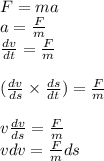
Aparticle of mass m moves along a straight line with initial speed vi. a force of magnitude f pushes the particle a distance d along the direction of its motion.
part b
by what multiplicative factor rk does the initial kinetic energy increase, and by what multiplicative factor rwdoes the work done by the force increase (with respect to the case when the particle had a mass m)?
if one of the quantities doubles, for instance, it would increase by a factor of 2. if a quantity stays the same, then the multiplicative factor would be 1.
you should enter the two factors separated by a comma.
part c
the particle's change in speed over the distance d will be the change in speed when it had a mass equal to m.
part d
by what factor rk does the initial kinetic energy increase (with respect to the first situation, with mass m and speed vi), and by what factor rw does the work done by the force increase?
again, enter the two factors, separated by a comma.
part e
the particle's change in speed over the distance d will be the change in speed when it had an initial velocity equal to vi.

Answers: 3
Another question on Physics

Physics, 22.06.2019 07:00
The seven sisters, seven stars located more than 400 light-years away in the taurus constellation can be seen here with venus and another constellation, orion. the seven stars stay grouped together but seem to move, like the planet venus. why do stars seem to move like planets in the night sky?
Answers: 3

Physics, 22.06.2019 11:30
While you are driving in the lane next to the curb on a multi-lane road the car on your left suddenly moves toward you lane. they are about toy crash into your front fender. you
Answers: 2

Physics, 22.06.2019 14:30
Which pair of quantities includes one quantity that increases as the other decreases during simple harmonic motion?
Answers: 1

Physics, 22.06.2019 20:20
Consider a file currently consisting of 200 blocks. assume that the file control block (and the index block in the case of indexed allocation) is already in memory. calculate how many disk i/o operations are required for contiguous, linked, and indexed (single-level) allocation strategies, for each of the conditions listed below. in the contiguous-allocation case, assume that there is not room to grow at the beginning but there is room to grow at the end. also assume that the block information to be added is stored in memory.
Answers: 3
You know the right answer?
Aparticle of mass m moves along a straight line with initial speed vi. a force of magnitude f pushes...
Questions

Mathematics, 13.01.2020 09:31

Mathematics, 13.01.2020 09:31

Mathematics, 13.01.2020 09:31

Mathematics, 13.01.2020 09:31

History, 13.01.2020 09:31

History, 13.01.2020 09:31

History, 13.01.2020 09:31

Mathematics, 13.01.2020 09:31

Mathematics, 13.01.2020 09:31


Chemistry, 13.01.2020 09:31


Social Studies, 13.01.2020 09:31

Computers and Technology, 13.01.2020 09:31





Computers and Technology, 13.01.2020 09:31







 represents the acceleration
represents the acceleration 

![v=3v\\\\K_1=\frac{1}{2}M(2v)^2\\\\=[tex]K_1=9(\frac{1}{2}M(v)^2)](/tpl/images/0407/7023/e4edc.png)
 ....(1)
....(1) is,
is, ....(2)
....(2)



